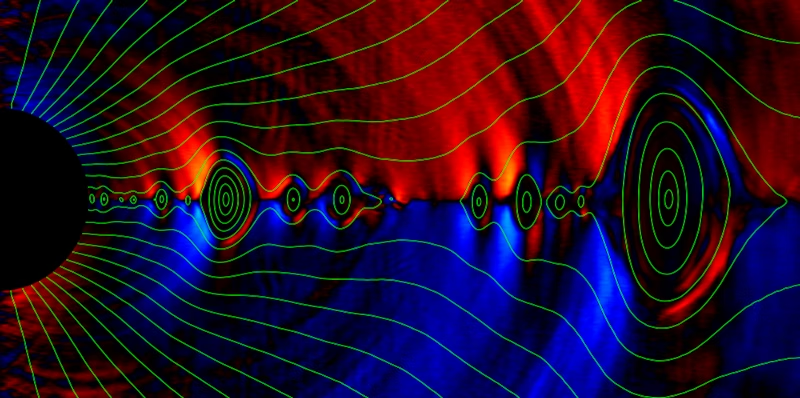Magnetic ‘Balding’ of Black Holes Saves General Relativity Prediction

Black holes aren’t what they eat. Einstein’s general relativity predicts that no matter what a black hole consumes, its external properties depend only on its mass, rotation and electric charge. All other details about its diet disappear. Astrophysicists whimsically call this the no-hair conjecture. (Black holes, they say, “have no hair.”)
There is a potentially hairy threat to the conjecture, though. Black holes can be born with a strong magnetic field or obtain one by munching on magnetized material. Such a field must quickly disappear for the no-hair conjecture to hold. But real black holes don’t exist in isolation. They can be surrounded by plasma — gas so energized that electrons have detached from their atoms — that can sustain the magnetic field, potentially disproving the conjecture.
Using supercomputer simulations of a plasma-engulfed black hole, researchers from the Flatiron Institute’s Center for Computational Astrophysics (CCA) in New York City, Columbia University and Princeton University found that the no-hair conjecture holds. The team reports its findings on July 27 in Physical Review Letters.
“The no-hair conjecture is a cornerstone of general relativity,” says study co-author Bart Ripperda, a research fellow at the CCA and a postdoctoral fellow at Princeton. “If a black hole has a long-lived magnetic field, then the no-hair conjecture is violated. Luckily a solution came from plasma physics that saved the no-hair conjecture from being broken.”
The team’s simulations showed that the magnetic field lines around the black hole quickly break and reconnect, creating plasma-filled pockets that launch into space or fall into the black hole’s maw. This process rapidly drains the magnetic field and could explain flares seen near supermassive black holes, the researchers report.
“Theorists didn’t think of this because they usually put their black holes in a vacuum,” Ripperda says. “But in real life, there’s often plasma, and plasma can sustain and bring in magnetic fields. And that has to fit with your no-hair conjecture.”
Ripperda co-authored the study with Columbia graduate student Ashley Bransgrove and CCA associate research scientist Sasha Philippov, who is also a visiting research scholar at Princeton.
By clicking to watch this video, you agree to our privacy policy.
A 2011 study on the problem suggested that the no-hair conjecture was in trouble. However, that study only looked at these systems at low resolution, and it treated plasma as a fluid. However, the plasma around a black hole is so diluted that particles rarely run into one another, so treating it as a fluid is an oversimplification.
In the new study, the researchers conducted high-resolution plasma physics simulations with a general-relativistic model of a black hole’s magnetic field. In total, it took 10 million CPU hours to churn through all the calculations. “We couldn’t have done these simulations without the Flatiron Institute’s computational resources,” Ripperda says.
The resulting simulations showed how the magnetic field around a black hole evolves. At first, the field extends in an arc from the black hole’s north pole to its south pole. Then, interactions within the plasma cause the field to balloon outward. This opening up causes the field to split into individual magnetic field lines that radiate outward from the black hole.
The field lines alternate in direction, either toward or away from the event horizon. Nearby magnetic field lines connect, creating a braided pattern of field lines coming together and splitting apart. Between two such connection points, a gap exists that fills with plasma. The plasma is energized by the magnetic field, launching outward into space or inward into the black hole. As the process continues, the magnetic field loses energy and eventually withers away.
Critically, the process happens fast. The researchers found that the black hole depletes its magnetic field at a rate of 10 percent of the speed of light. “The fast reconnection saved the no-hair conjecture,” Ripperda says.
The researchers propose that the mechanism powering observed flares from the supermassive black hole at the center of the Messier 87 galaxy could be explained by the balding process seen in the simulations. Initial comparisons between them look promising, they say, though a more robust assessment is needed. If they do indeed line up, energetic flares powered by magnetic reconnection at black hole event horizons may be a widespread phenomenon.
The authors acknowledge support by the National Science Foundation under Grants No. PHY-2010145.
Information for Press
For more information, please contact Stacey Greenebaum at [email protected].


